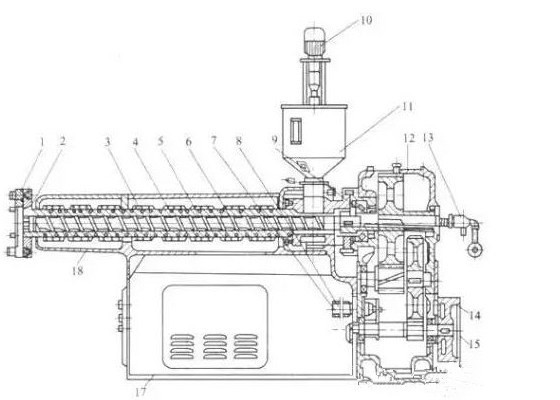The Most Simple Single-Screw Extruder
The most simple single-screw extruder, it is also extremely important production equipment, let us know the extruder ancestor now!
The basic structure of a single-screw extruder:
Single-screw extruder is the most common extrusion equipment, including the host, auxiliary equipment and electrical control systems.
Host containing extrusion system (barrel and screw), transmission, feeding systems and heating and cooling systems. Screw extruder is the heart, is a key component that can directly affect the scope and efficiency of the extruder. By turning the screw so that the material in the barrel can move, pressure and get some of the heat from the friction, and its performance is good or bad determines the productivity, the quality of a plastics extruder, filling material dispersion, melt temperature, power consumption and so on.

Single-screw extruder process:
Ordinary single-screw extruder, also known as three-screw extruder. When the material went forward along the screw, experiencing changes in temperature, pressure, viscosity, etc., according to the characteristics of the material may change in the effective length of the screw is divided into three sections, namely feed zone (solid conveying zone), melting zone (compression section) and homogenizing section (metering section), according to the screw diameter, pitch, spiral groove depth to determine the effective length of three sections.
Conventional full-thread screw three sections according to their thread lift and change the depth of the grooves can be divided into equidistant darker screw, and other deep-pitch screw and a variable pitch screw depth.
New single-screw extruder:
In each functional segment three-screw extruder, there are some problems that restrict the production, such as the melting zone solid bed and bath cohabitation a screw slot, widened the pool constantly, solid bed is gradually narrowed, reduced the solid bed heat transfer area and barrel wall and transfer heat to melt the solid debris surrounded suffered shear force is small, slow melt, and even cause uneven quality problems.
To pursuit high-speed and high-yield extrusion on the basis of high-quality, developed a variety of new screw to overcome the limitations of conventional three-zone screw the whole thread, and there are many features to improve extrusion rate, quality plastics and reduce volatility, has been more widely used.
Separate screw
Separate screw a new type screw which researched according to the principle of heat transfer screw. In the melting zone, added a secondary thread barrier function.
Barrier screw
Barrier screw comes from the separation type screw, provided barrier segment in a part of an ordinary screw. It is a new screw to melt and homogenize a solid phase thoroughly.
Pin screw
Pin Screw is a shunt screw, use screw pin which can provide on stream containing solid particles seperated into many small streams.
DIS screw
DIS screw is also a shunt screw. Provided in the ordinary screw-terminal segment of the DIS mixing head.
Combined screw is used to solve the contradiction between the extruder dedicated and versatile, with the body by the screw feed zone and a variety of screw elements of different functions (such as conveying elements, mixing elements and shearing elements etc.). Changing the type, quantity and combination sequence elements, can get various properties of the screw to accommodate different materials and different parts of processing requirements, and find the best working conditions.
This screw adaptable, easy to get the best working conditions, and therefore be more widely applied. But the design of complex, combinations of elements disassembly is cumbersome, more difficult to achieve on a smaller diameter screw.
Applications range of Single-screw extruder machine:
Single screw extruder is mainly used for EPS foam hard / soft polyvinyl chloride, polyethylene foam and other thermoplastic extrusion process, and the corresponding auxiliary equipment and building core to produce several kinds of plastic products, such as tubes, sheets, films, ribbons, etc., can be used for granulation.
